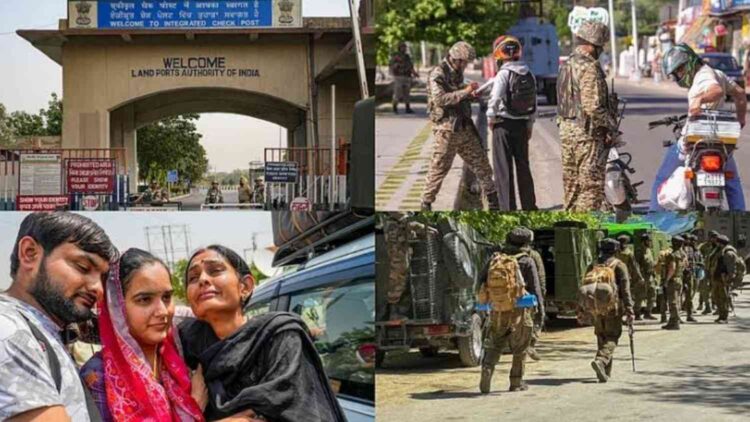Border security is not a simple task for a huge and diverse country like India. The boundaries adjacent to countries like Pakistan, Bangladesh, Myanmar and Nepal have been historic, geographical and politically extremely complex. In the last few years, India has made elaborate efforts to secure borders, yet the problem of infiltration is taking a formidable form. Recently, the killing of 26 innocent citizens in a horrific terrorist attack in Pahalgam, Jammu and Kashmir, has brought out the magnitude of this crisis again. The organization called ‘Kashmir Resistance’ takes responsibility for this attack, and the role of Pakistan -backed system behind it shows that infiltration has now become the main means of organized terrorism, but also the infiltration. Every intrusion on the borders is not only the encroachment of the land, but also a deep attack on the sovereignty of the nation. Due to this, India has a multidimensional crisis, including questions like security, social balance and economic pressure.
If we look at the major sources of infiltration in India, the biggest danger comes from Bangladesh. An estimated 2-3 million Bangladeshi citizens are illegally living in India, most of which are inhabited in Assam, West Bengal, Tripura and Bihar. Taking advantage of Nepal’s open limit, economic infiltration has also been in large numbers. In recent years, thousands of refugees from Rohingya and Chin community from Myanmar have settled in the states of Manipur and Mizoram in India. According to a World Bank report, illegal immigration from Bangladesh to India has completely changed the population structure in some border districts, increasing the feeling of dissatisfaction and insecurity among the local residents. Bangladeshi intruders also cause serious economic losses to Indian citizens due to the competition of cheap wages in the employment market. At the same time, evidence of some elements coming from Myanmar having relations with armed groups has also been found, which is promoting ethnic conflict and violence in Northeast India.
Infiltration from the attitude of national security has become a very serious crisis. According to reports, Indian borders have become an easy way for terrorists trained and sent by Pakistan. Not only illegal citizens are entering through infiltration from Bangladesh, but smuggling of fake Indian currency and narcotics is also happening on a large scale. According to an analysis, there has been an increase of more than 10% every year in cross -border crimes. In the Northeast India, the intruders from Myanmar have spoiled the ethnic balance and in many places the local versus external conflicts are deep. This not only creates internal instability, but also gives strength to separatist feelings within India. When illegal migrants occupy the resources, jobs and lands of local citizens, there is a situation of mistrust, violence and polarization in the society. This situation weakens the unity and integrity of the nation in a long time.
The government has taken several important steps to deal with the problem of infiltration. The process of fencing on the Indo-Bangladesh border has been completed to a large extent and now electronic monitoring has also been included under the Smart Fencing Project. 1,643 km long fencing work has been started on the Indo-Myanmar border, so that illegal migrants coming from Myanmar can be stopped. Additionally, attempts have been made to identify illegal citizens in Assam through initiatives like National Register of Citizens (NRC). After removing Article 370 in Jammu and Kashmir, the deployment of the Border Security Force and Army has been further strengthened. Recently, India has also partly suspended the Indus Water Treaty with Pakistan to put pressure on terrorism across the border. However, despite all these efforts, lack of a coordinated and national level is still being felt.
There are also many major challenges in the path of preventing infiltration. Complex geographical forms of borders, such as river, swamp, dense forest and icy area, make monitoring difficult. Helping intruders for economic benefit by some local people in the border areas is also a serious problem. In addition, harsh action is interrupted many times due to timely intervention by human rights organizations and courts. Political parties also often take a soft attitude towards intruders due to vote bank politics. To deal with this crisis, India will have to make wide use of state -of -the -art technology (such as drone monitoring, sensor -based alert system). Local communities in the border areas will have to be made aware and empowered, so that they can inform the infiltration on time. The national identity system should also be strengthened so that illegal citizens can be identified quickly and accurately. Above all, it is mandatory to strengthen political will.
The infiltration problem is not only a geography or administrative issue, but it is a crisis related to the social, economic and political future of India. If it is not a decisive and comprehensive action on it in time, then India will face problems like internal instability, economic pressure and social disintegration in the coming years. Infiltration should be seen not only by security glasses, but as a question of national existence. Today it is necessary that India should adopt a holistic view – in which border management, citizenship policy, economic development, and social integration can be taken together. India’s integrity and sovereignty will not only protect from the presence of soldiers on the borders, but will be from strong social fabric and uniform civil identity within the nation. Therefore, the time has come to top the issue of infiltration in national priority and it should be resolved with full power.










